Effective and Ineffective Communication in Healthcare: A Case Study
VerifiedAdded on 2023/01/09
|9
|2337
|84
Essay
AI Summary
This essay examines effective and ineffective communication within a healthcare setting, drawing from a film and relevant literature. It analyzes instances of both proper and improper communication, particularly focusing on the interactions between healthcare professionals and a patient. The essay highlights the importance of interpersonal skills, nonverbal cues, and empathetic communication in establishing a strong doctor-patient relationship and improving patient outcomes. Examples from the film are used to illustrate poor communication practices, such as withholding information and failing to recognize patient expressions, and contrast them with effective approaches that prioritize patient autonomy and understanding. The reflection section details the author's insights gained from observing the film, emphasizing the significance of creating connections with patients, reading nonverbal cues, and sharing information to facilitate informed decision-making. The author also expresses a commitment to adopting effective communication practices in their future professional role.
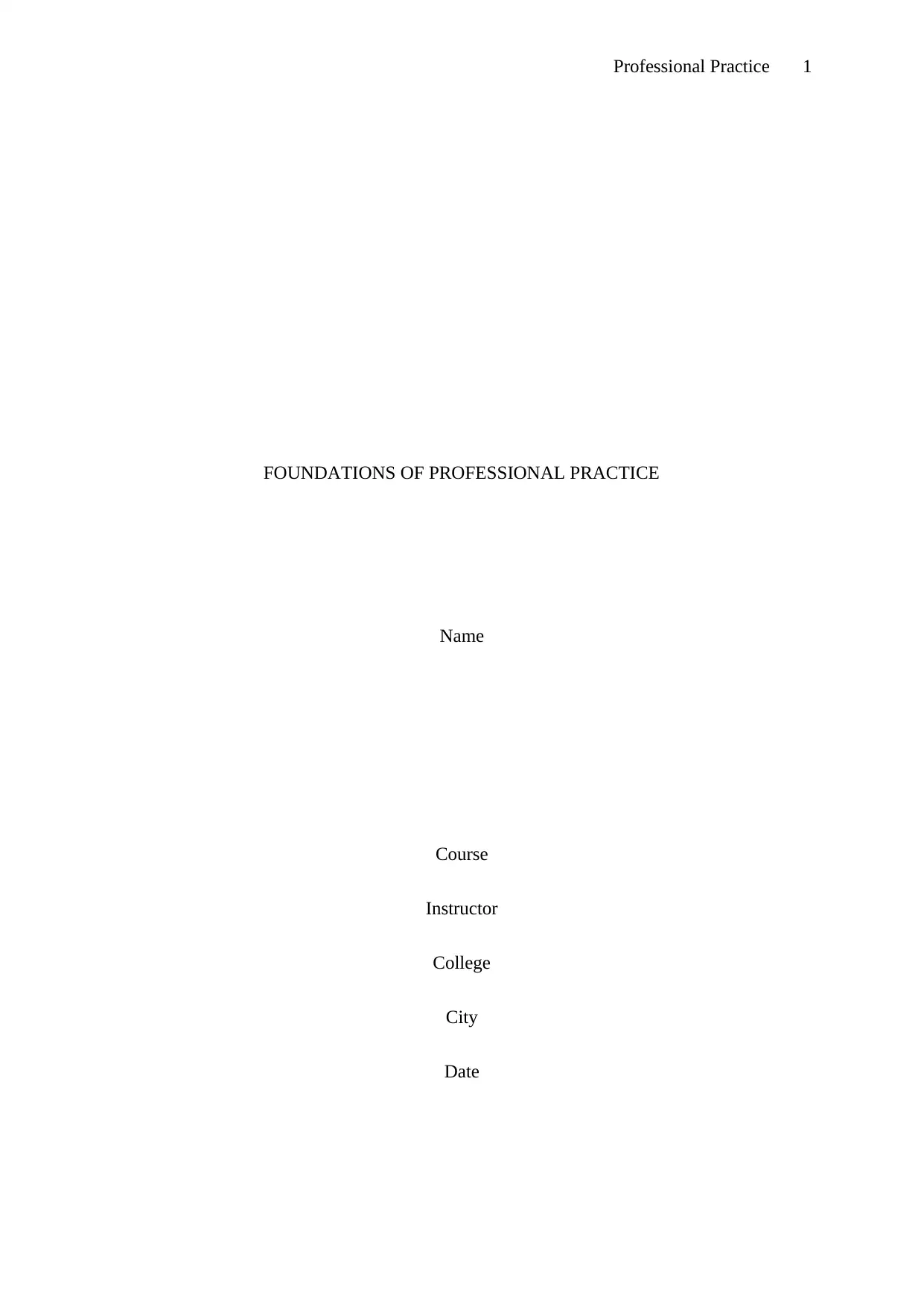
Professional Practice 1
FOUNDATIONS OF PROFESSIONAL PRACTICE
Name
Course
Instructor
College
City
Date
FOUNDATIONS OF PROFESSIONAL PRACTICE
Name
Course
Instructor
College
City
Date
Paraphrase This Document
Need a fresh take? Get an instant paraphrase of this document with our AI Paraphraser
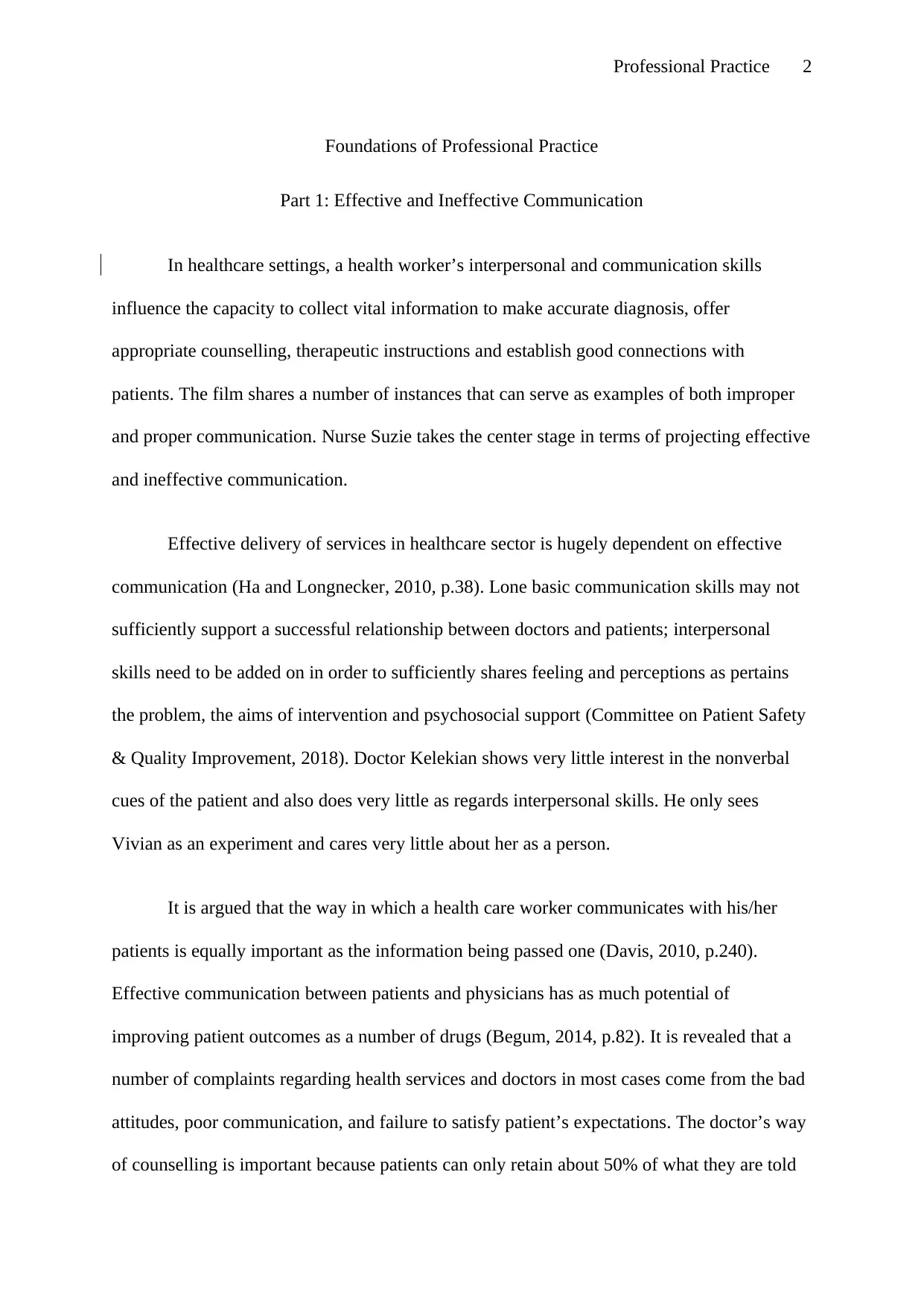
Professional Practice 2
Foundations of Professional Practice
Part 1: Effective and Ineffective Communication
In healthcare settings, a health worker’s interpersonal and communication skills
influence the capacity to collect vital information to make accurate diagnosis, offer
appropriate counselling, therapeutic instructions and establish good connections with
patients. The film shares a number of instances that can serve as examples of both improper
and proper communication. Nurse Suzie takes the center stage in terms of projecting effective
and ineffective communication.
Effective delivery of services in healthcare sector is hugely dependent on effective
communication (Ha and Longnecker, 2010, p.38). Lone basic communication skills may not
sufficiently support a successful relationship between doctors and patients; interpersonal
skills need to be added on in order to sufficiently shares feeling and perceptions as pertains
the problem, the aims of intervention and psychosocial support (Committee on Patient Safety
& Quality Improvement, 2018). Doctor Kelekian shows very little interest in the nonverbal
cues of the patient and also does very little as regards interpersonal skills. He only sees
Vivian as an experiment and cares very little about her as a person.
It is argued that the way in which a health care worker communicates with his/her
patients is equally important as the information being passed one (Davis, 2010, p.240).
Effective communication between patients and physicians has as much potential of
improving patient outcomes as a number of drugs (Begum, 2014, p.82). It is revealed that a
number of complaints regarding health services and doctors in most cases come from the bad
attitudes, poor communication, and failure to satisfy patient’s expectations. The doctor’s way
of counselling is important because patients can only retain about 50% of what they are told
Foundations of Professional Practice
Part 1: Effective and Ineffective Communication
In healthcare settings, a health worker’s interpersonal and communication skills
influence the capacity to collect vital information to make accurate diagnosis, offer
appropriate counselling, therapeutic instructions and establish good connections with
patients. The film shares a number of instances that can serve as examples of both improper
and proper communication. Nurse Suzie takes the center stage in terms of projecting effective
and ineffective communication.
Effective delivery of services in healthcare sector is hugely dependent on effective
communication (Ha and Longnecker, 2010, p.38). Lone basic communication skills may not
sufficiently support a successful relationship between doctors and patients; interpersonal
skills need to be added on in order to sufficiently shares feeling and perceptions as pertains
the problem, the aims of intervention and psychosocial support (Committee on Patient Safety
& Quality Improvement, 2018). Doctor Kelekian shows very little interest in the nonverbal
cues of the patient and also does very little as regards interpersonal skills. He only sees
Vivian as an experiment and cares very little about her as a person.
It is argued that the way in which a health care worker communicates with his/her
patients is equally important as the information being passed one (Davis, 2010, p.240).
Effective communication between patients and physicians has as much potential of
improving patient outcomes as a number of drugs (Begum, 2014, p.82). It is revealed that a
number of complaints regarding health services and doctors in most cases come from the bad
attitudes, poor communication, and failure to satisfy patient’s expectations. The doctor’s way
of counselling is important because patients can only retain about 50% of what they are told
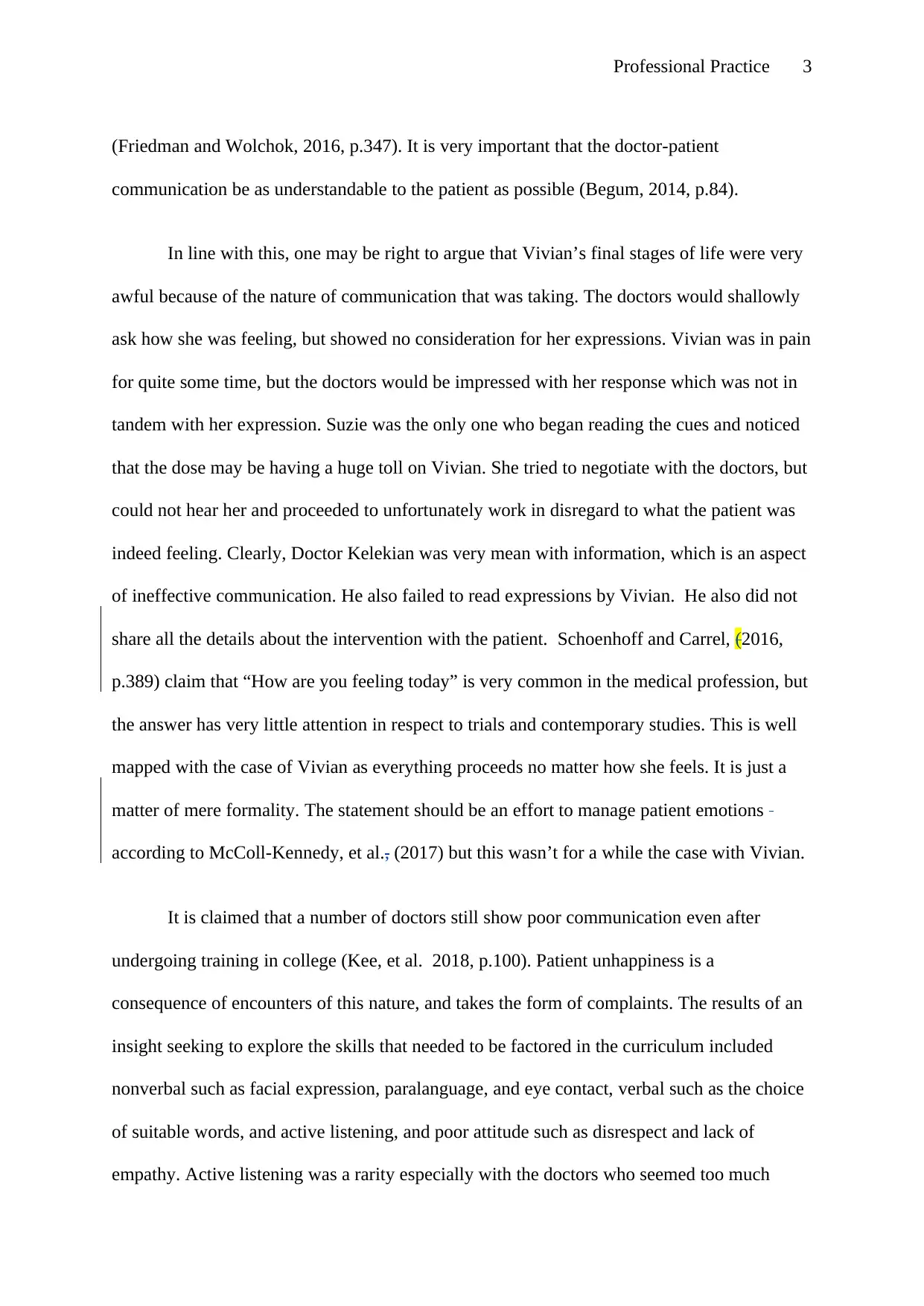
Professional Practice 3
(Friedman and Wolchok, 2016, p.347). It is very important that the doctor-patient
communication be as understandable to the patient as possible (Begum, 2014, p.84).
In line with this, one may be right to argue that Vivian’s final stages of life were very
awful because of the nature of communication that was taking. The doctors would shallowly
ask how she was feeling, but showed no consideration for her expressions. Vivian was in pain
for quite some time, but the doctors would be impressed with her response which was not in
tandem with her expression. Suzie was the only one who began reading the cues and noticed
that the dose may be having a huge toll on Vivian. She tried to negotiate with the doctors, but
could not hear her and proceeded to unfortunately work in disregard to what the patient was
indeed feeling. Clearly, Doctor Kelekian was very mean with information, which is an aspect
of ineffective communication. He also failed to read expressions by Vivian. He also did not
share all the details about the intervention with the patient. Schoenhoff and Carrel, (2016,
p.389) claim that “How are you feeling today” is very common in the medical profession, but
the answer has very little attention in respect to trials and contemporary studies. This is well
mapped with the case of Vivian as everything proceeds no matter how she feels. It is just a
matter of mere formality. The statement should be an effort to manage patient emotions
according to McColl-Kennedy, et al., (2017) but this wasn’t for a while the case with Vivian.
It is claimed that a number of doctors still show poor communication even after
undergoing training in college (Kee, et al. 2018, p.100). Patient unhappiness is a
consequence of encounters of this nature, and takes the form of complaints. The results of an
insight seeking to explore the skills that needed to be factored in the curriculum included
nonverbal such as facial expression, paralanguage, and eye contact, verbal such as the choice
of suitable words, and active listening, and poor attitude such as disrespect and lack of
empathy. Active listening was a rarity especially with the doctors who seemed too much
(Friedman and Wolchok, 2016, p.347). It is very important that the doctor-patient
communication be as understandable to the patient as possible (Begum, 2014, p.84).
In line with this, one may be right to argue that Vivian’s final stages of life were very
awful because of the nature of communication that was taking. The doctors would shallowly
ask how she was feeling, but showed no consideration for her expressions. Vivian was in pain
for quite some time, but the doctors would be impressed with her response which was not in
tandem with her expression. Suzie was the only one who began reading the cues and noticed
that the dose may be having a huge toll on Vivian. She tried to negotiate with the doctors, but
could not hear her and proceeded to unfortunately work in disregard to what the patient was
indeed feeling. Clearly, Doctor Kelekian was very mean with information, which is an aspect
of ineffective communication. He also failed to read expressions by Vivian. He also did not
share all the details about the intervention with the patient. Schoenhoff and Carrel, (2016,
p.389) claim that “How are you feeling today” is very common in the medical profession, but
the answer has very little attention in respect to trials and contemporary studies. This is well
mapped with the case of Vivian as everything proceeds no matter how she feels. It is just a
matter of mere formality. The statement should be an effort to manage patient emotions
according to McColl-Kennedy, et al., (2017) but this wasn’t for a while the case with Vivian.
It is claimed that a number of doctors still show poor communication even after
undergoing training in college (Kee, et al. 2018, p.100). Patient unhappiness is a
consequence of encounters of this nature, and takes the form of complaints. The results of an
insight seeking to explore the skills that needed to be factored in the curriculum included
nonverbal such as facial expression, paralanguage, and eye contact, verbal such as the choice
of suitable words, and active listening, and poor attitude such as disrespect and lack of
empathy. Active listening was a rarity especially with the doctors who seemed too much
⊘ This is a preview!⊘
Do you want full access?
Subscribe today to unlock all pages.

Trusted by 1+ million students worldwide
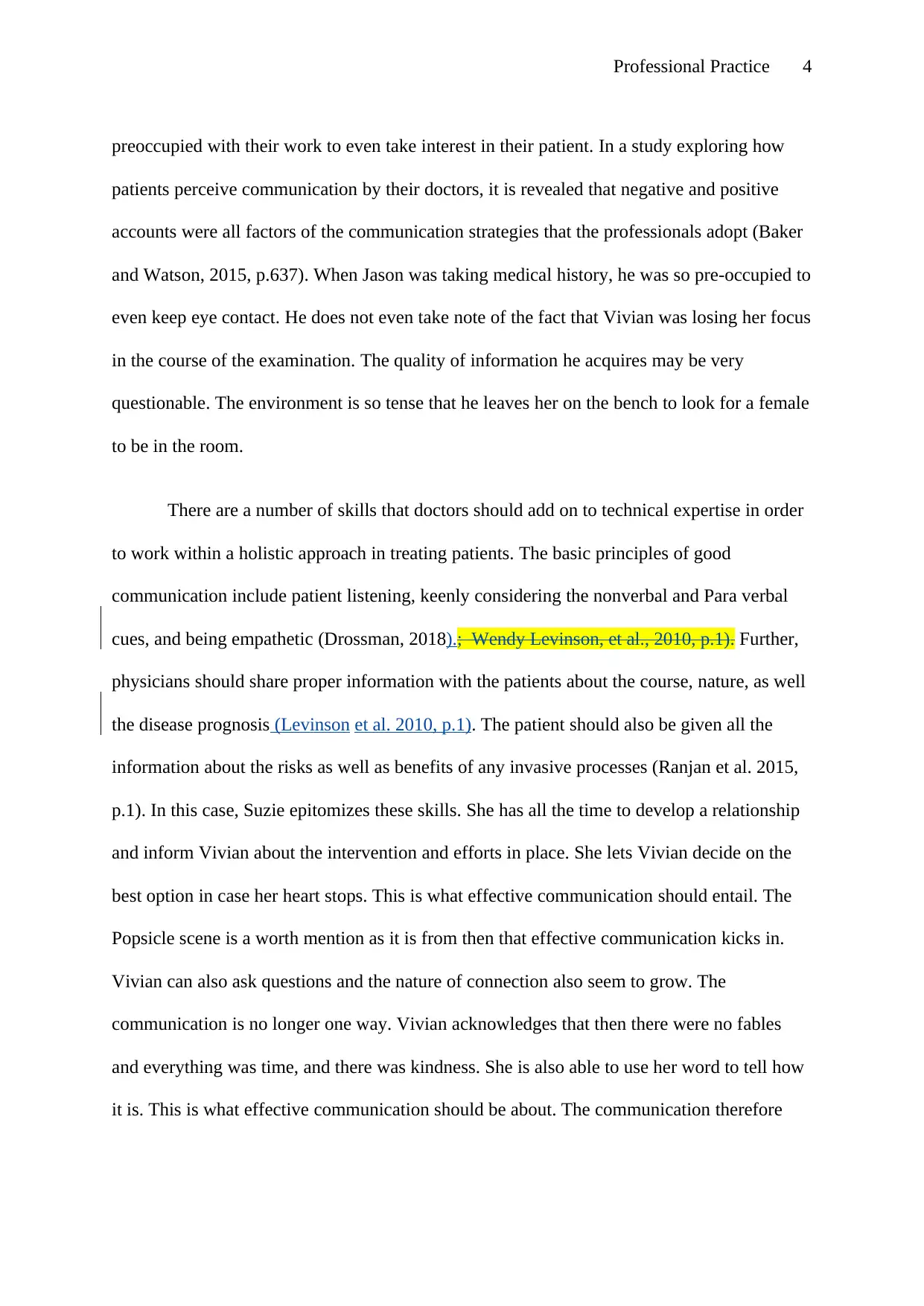
Professional Practice 4
preoccupied with their work to even take interest in their patient. In a study exploring how
patients perceive communication by their doctors, it is revealed that negative and positive
accounts were all factors of the communication strategies that the professionals adopt (Baker
and Watson, 2015, p.637). When Jason was taking medical history, he was so pre-occupied to
even keep eye contact. He does not even take note of the fact that Vivian was losing her focus
in the course of the examination. The quality of information he acquires may be very
questionable. The environment is so tense that he leaves her on the bench to look for a female
to be in the room.
There are a number of skills that doctors should add on to technical expertise in order
to work within a holistic approach in treating patients. The basic principles of good
communication include patient listening, keenly considering the nonverbal and Para verbal
cues, and being empathetic (Drossman, 2018).; Wendy Levinson, et al., 2010, p.1). Further,
physicians should share proper information with the patients about the course, nature, as well
the disease prognosis (Levinson et al. 2010, p.1). The patient should also be given all the
information about the risks as well as benefits of any invasive processes (Ranjan et al. 2015,
p.1). In this case, Suzie epitomizes these skills. She has all the time to develop a relationship
and inform Vivian about the intervention and efforts in place. She lets Vivian decide on the
best option in case her heart stops. This is what effective communication should entail. The
Popsicle scene is a worth mention as it is from then that effective communication kicks in.
Vivian can also ask questions and the nature of connection also seem to grow. The
communication is no longer one way. Vivian acknowledges that then there were no fables
and everything was time, and there was kindness. She is also able to use her word to tell how
it is. This is what effective communication should be about. The communication therefore
preoccupied with their work to even take interest in their patient. In a study exploring how
patients perceive communication by their doctors, it is revealed that negative and positive
accounts were all factors of the communication strategies that the professionals adopt (Baker
and Watson, 2015, p.637). When Jason was taking medical history, he was so pre-occupied to
even keep eye contact. He does not even take note of the fact that Vivian was losing her focus
in the course of the examination. The quality of information he acquires may be very
questionable. The environment is so tense that he leaves her on the bench to look for a female
to be in the room.
There are a number of skills that doctors should add on to technical expertise in order
to work within a holistic approach in treating patients. The basic principles of good
communication include patient listening, keenly considering the nonverbal and Para verbal
cues, and being empathetic (Drossman, 2018).; Wendy Levinson, et al., 2010, p.1). Further,
physicians should share proper information with the patients about the course, nature, as well
the disease prognosis (Levinson et al. 2010, p.1). The patient should also be given all the
information about the risks as well as benefits of any invasive processes (Ranjan et al. 2015,
p.1). In this case, Suzie epitomizes these skills. She has all the time to develop a relationship
and inform Vivian about the intervention and efforts in place. She lets Vivian decide on the
best option in case her heart stops. This is what effective communication should entail. The
Popsicle scene is a worth mention as it is from then that effective communication kicks in.
Vivian can also ask questions and the nature of connection also seem to grow. The
communication is no longer one way. Vivian acknowledges that then there were no fables
and everything was time, and there was kindness. She is also able to use her word to tell how
it is. This is what effective communication should be about. The communication therefore
Paraphrase This Document
Need a fresh take? Get an instant paraphrase of this document with our AI Paraphraser

Professional Practice 5
seems to adjust towards what can be deemed effective following this scene, and one may be
right to claim that the quality of care also seemed to get better.
Sun and Rau (2017) explore the impediments to proper doctor-patient communication
and reveal lower medical literacy levels of patients, higher workloads for physicians,
defensive behaviors among the physicians, and lack of understanding communication skills
as pronounced barriers. The need to work on these challenges is seen as very important in
realizing effective doctor patient communication and improved health outcomes. These are
factors that can be well-read with the doctors involved in this case. Jason is so full of himself
to the extent of disregarding the fact that the patient was DNR and had it not been for Suzie
would have gone against the will of the patient. Respect is therefore an important ingredient
of effective communication and Jason has to act in respect to what had been set by the patient
even if it is against his objectives.
The patient should remain at the core of any service to be offered including surgical
interventions. Patient’s autonomy needs to be respected in the course of and following the
informed consent process. Majority of patient complaints pertain communication matters of
doctors and have very little as regards clinical competence ((McAlinden, 2014, p.1). This
highlights the centrality of communication in the confines of doctor-patient interactions.
Vivian may not initially have been at the center of communication, but thanks to Suzie, she
takes it as is able to dictate on the direction her life should take and liberate herself from
being labelled research. In this case, one would be right to argue that Suzie was central to the
way in which the communication became effective by ensuring that Vivian was at the center
of it.
Part 2: Reflection
seems to adjust towards what can be deemed effective following this scene, and one may be
right to claim that the quality of care also seemed to get better.
Sun and Rau (2017) explore the impediments to proper doctor-patient communication
and reveal lower medical literacy levels of patients, higher workloads for physicians,
defensive behaviors among the physicians, and lack of understanding communication skills
as pronounced barriers. The need to work on these challenges is seen as very important in
realizing effective doctor patient communication and improved health outcomes. These are
factors that can be well-read with the doctors involved in this case. Jason is so full of himself
to the extent of disregarding the fact that the patient was DNR and had it not been for Suzie
would have gone against the will of the patient. Respect is therefore an important ingredient
of effective communication and Jason has to act in respect to what had been set by the patient
even if it is against his objectives.
The patient should remain at the core of any service to be offered including surgical
interventions. Patient’s autonomy needs to be respected in the course of and following the
informed consent process. Majority of patient complaints pertain communication matters of
doctors and have very little as regards clinical competence ((McAlinden, 2014, p.1). This
highlights the centrality of communication in the confines of doctor-patient interactions.
Vivian may not initially have been at the center of communication, but thanks to Suzie, she
takes it as is able to dictate on the direction her life should take and liberate herself from
being labelled research. In this case, one would be right to argue that Suzie was central to the
way in which the communication became effective by ensuring that Vivian was at the center
of it.
Part 2: Reflection

Professional Practice 6
From watching this film, I have gained valuable lessons that will improve my I
believe will better my knowledge and skills and knowledge in nursingimprove my practice. I
now appreciate that it is very important to create a connection with patients because it is from
such a link that a patient can be at ease to express their concerns and make choices. From the
way in which Vivian interacted with Suzie, I must say that our practice may be very
unsatisfying if we cannot establish relationships of that nature. I have noted that
communication goes beyond the verbal to reading cues that play a very important role. A
patient may say that they are feeling okay because of the tension in the room. This makes it
very important to break the ice and establish an environment of freedom. Suzie managed to
establish a connection by availing herself and trying to fit Vivian’s level by sharing the
Popsicle. This may mean that sometimes we may need to work in environments that may be
uncomfortable for us in order to give the best to the patients. Jason and Kelekian are the
epitome of poor communication and have helped me gather important lessons as well. There
is need to treat people with respect no matter our positions. They seemed too much
preoccupied with other issues and only saw the patients as research. Never at any point did
these physicians try to fit into the shoes of the lady and handle her feelings and fears. I plan to
never be a practitioner of this nature.
Sharing of information with patients is a lesson that I have gathered from this film.
The doctors withheld information which was not only unethical but disrespectful. It is always
important to share information and let patients make the decisions. I intend to be a
practitioner who shares all the information and supports the decisions by the patients.
From watching this film, I have gained valuable lessons that will improve my I
believe will better my knowledge and skills and knowledge in nursingimprove my practice. I
now appreciate that it is very important to create a connection with patients because it is from
such a link that a patient can be at ease to express their concerns and make choices. From the
way in which Vivian interacted with Suzie, I must say that our practice may be very
unsatisfying if we cannot establish relationships of that nature. I have noted that
communication goes beyond the verbal to reading cues that play a very important role. A
patient may say that they are feeling okay because of the tension in the room. This makes it
very important to break the ice and establish an environment of freedom. Suzie managed to
establish a connection by availing herself and trying to fit Vivian’s level by sharing the
Popsicle. This may mean that sometimes we may need to work in environments that may be
uncomfortable for us in order to give the best to the patients. Jason and Kelekian are the
epitome of poor communication and have helped me gather important lessons as well. There
is need to treat people with respect no matter our positions. They seemed too much
preoccupied with other issues and only saw the patients as research. Never at any point did
these physicians try to fit into the shoes of the lady and handle her feelings and fears. I plan to
never be a practitioner of this nature.
Sharing of information with patients is a lesson that I have gathered from this film.
The doctors withheld information which was not only unethical but disrespectful. It is always
important to share information and let patients make the decisions. I intend to be a
practitioner who shares all the information and supports the decisions by the patients.
⊘ This is a preview!⊘
Do you want full access?
Subscribe today to unlock all pages.

Trusted by 1+ million students worldwide
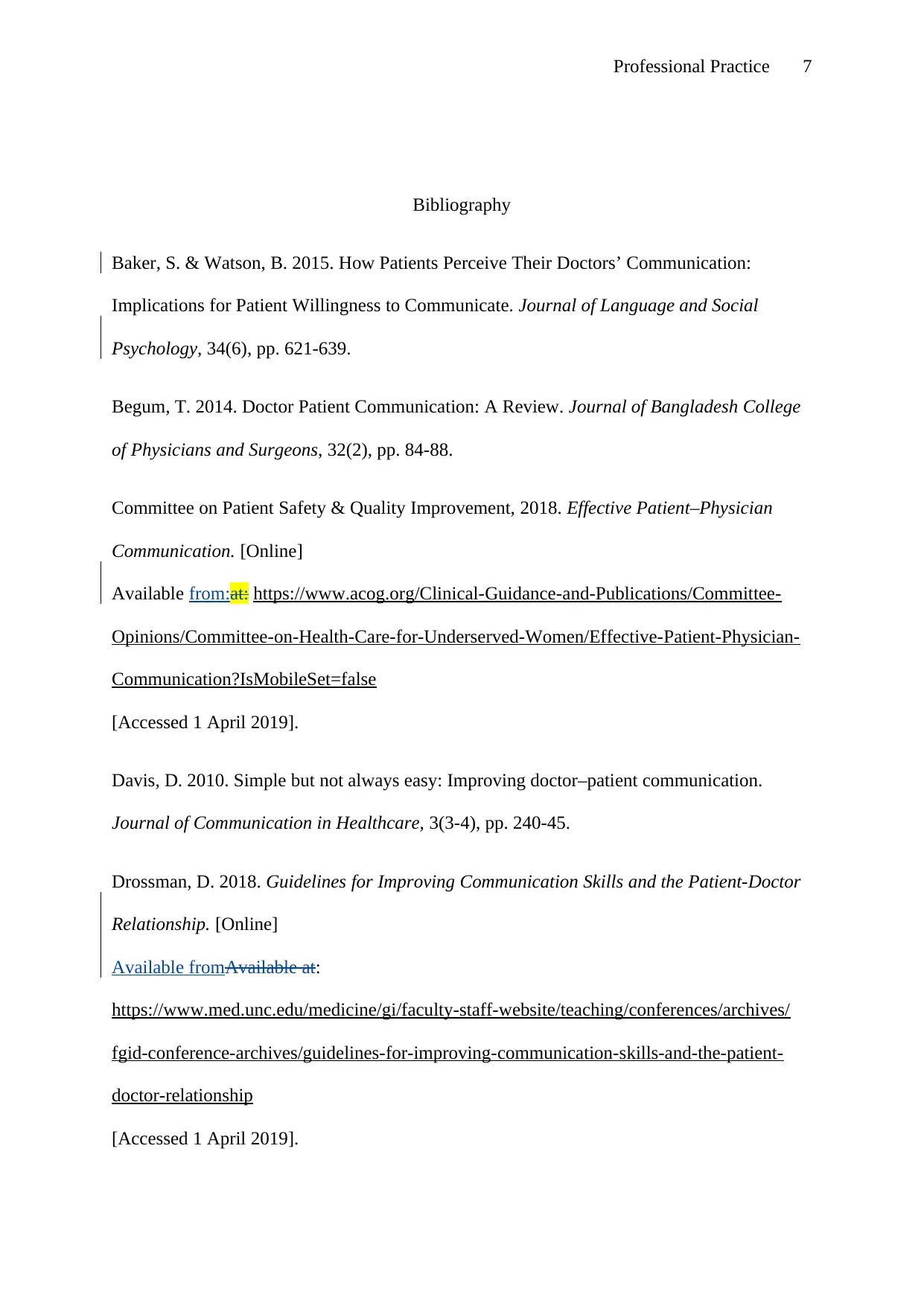
Professional Practice 7
Bibliography
Baker, S. & Watson, B. 2015. How Patients Perceive Their Doctors’ Communication:
Implications for Patient Willingness to Communicate. Journal of Language and Social
Psychology, 34(6), pp. 621-639.
Begum, T. 2014. Doctor Patient Communication: A Review. Journal of Bangladesh College
of Physicians and Surgeons, 32(2), pp. 84-88.
Committee on Patient Safety & Quality Improvement, 2018. Effective Patient–Physician
Communication. [Online]
Available from:at: https://www.acog.org/Clinical-Guidance-and-Publications/Committee-
Opinions/Committee-on-Health-Care-for-Underserved-Women/Effective-Patient-Physician-
Communication?IsMobileSet=false
[Accessed 1 April 2019].
Davis, D. 2010. Simple but not always easy: Improving doctor–patient communication.
Journal of Communication in Healthcare, 3(3-4), pp. 240-45.
Drossman, D. 2018. Guidelines for Improving Communication Skills and the Patient-Doctor
Relationship. [Online]
Available fromAvailable at:
https://www.med.unc.edu/medicine/gi/faculty-staff-website/teaching/conferences/archives/
fgid-conference-archives/guidelines-for-improving-communication-skills-and-the-patient-
doctor-relationship
[Accessed 1 April 2019].
Bibliography
Baker, S. & Watson, B. 2015. How Patients Perceive Their Doctors’ Communication:
Implications for Patient Willingness to Communicate. Journal of Language and Social
Psychology, 34(6), pp. 621-639.
Begum, T. 2014. Doctor Patient Communication: A Review. Journal of Bangladesh College
of Physicians and Surgeons, 32(2), pp. 84-88.
Committee on Patient Safety & Quality Improvement, 2018. Effective Patient–Physician
Communication. [Online]
Available from:at: https://www.acog.org/Clinical-Guidance-and-Publications/Committee-
Opinions/Committee-on-Health-Care-for-Underserved-Women/Effective-Patient-Physician-
Communication?IsMobileSet=false
[Accessed 1 April 2019].
Davis, D. 2010. Simple but not always easy: Improving doctor–patient communication.
Journal of Communication in Healthcare, 3(3-4), pp. 240-45.
Drossman, D. 2018. Guidelines for Improving Communication Skills and the Patient-Doctor
Relationship. [Online]
Available fromAvailable at:
https://www.med.unc.edu/medicine/gi/faculty-staff-website/teaching/conferences/archives/
fgid-conference-archives/guidelines-for-improving-communication-skills-and-the-patient-
doctor-relationship
[Accessed 1 April 2019].
Paraphrase This Document
Need a fresh take? Get an instant paraphrase of this document with our AI Paraphraser

Professional Practice 8
Friedman, C. & Wolchok, J. 2016. Patient-Physician Communication in the 21st Century.
Scientific Life Series: Training The Next Generation, SCIENTIFIC LIFE SERIES: TRAINING
THE NEXT GENERATION, 37(6), pp. 347-349.
Ha, J. & Longnecker, N. 2010. Doctor-Patient Communication: A Review. Ochsner Journal,
10(1), pp. 38-43.
Kee, J., SingKhoo, H., Lim, I. & Koh, M. 2018. Communication Skills in Patient-Doctor
Interactions: Learning from Patient Complaints. Health Professions Education, 4(2), pp. 97-
106.
McAlinden, C. 2014. The importance of doctor–patient communication. British Journal of
Hospital Medicine, 75(2), pp. 64-65.
McColl-Kennedy, J. et al., 2017. How do you feel today? Managing patient emotions during
health care experiences to enhance well-being. Journal of Business Research, Volume 2017,
pp. 1-17.
Ranjan, P., Kumari, A. & Chakrawarty, A. 2015. How can Doctors Improve their
Communication Skills?. Journal of Clinical and Diagnostic Research : JCDR, 9(3), pp. 1-4.
Schoenhoff, F. & Carrel, T., 2016. How are you feeling today? Quality of life after aortic
surgery. European Journal of Cardio-Thoracic Surgery., 49(2), pp. 389-90.
Sun, N. & Rau, P. (2017)2017. Barriers to improve physician–patient communication in a
primary care setting: perspectives of Chinese physicians. Health Psychology and Behavioral
Medicine, 5(1), pp. 166-76.
Levinson, W., Lesser, C. & Epstein, R. 2010. Developing Physician Communication Skills
For Patient-Centered Care. Health Affairs, 29(7), p. 1.
Friedman, C. & Wolchok, J. 2016. Patient-Physician Communication in the 21st Century.
Scientific Life Series: Training The Next Generation, SCIENTIFIC LIFE SERIES: TRAINING
THE NEXT GENERATION, 37(6), pp. 347-349.
Ha, J. & Longnecker, N. 2010. Doctor-Patient Communication: A Review. Ochsner Journal,
10(1), pp. 38-43.
Kee, J., SingKhoo, H., Lim, I. & Koh, M. 2018. Communication Skills in Patient-Doctor
Interactions: Learning from Patient Complaints. Health Professions Education, 4(2), pp. 97-
106.
McAlinden, C. 2014. The importance of doctor–patient communication. British Journal of
Hospital Medicine, 75(2), pp. 64-65.
McColl-Kennedy, J. et al., 2017. How do you feel today? Managing patient emotions during
health care experiences to enhance well-being. Journal of Business Research, Volume 2017,
pp. 1-17.
Ranjan, P., Kumari, A. & Chakrawarty, A. 2015. How can Doctors Improve their
Communication Skills?. Journal of Clinical and Diagnostic Research : JCDR, 9(3), pp. 1-4.
Schoenhoff, F. & Carrel, T., 2016. How are you feeling today? Quality of life after aortic
surgery. European Journal of Cardio-Thoracic Surgery., 49(2), pp. 389-90.
Sun, N. & Rau, P. (2017)2017. Barriers to improve physician–patient communication in a
primary care setting: perspectives of Chinese physicians. Health Psychology and Behavioral
Medicine, 5(1), pp. 166-76.
Levinson, W., Lesser, C. & Epstein, R. 2010. Developing Physician Communication Skills
For Patient-Centered Care. Health Affairs, 29(7), p. 1.

Professional Practice 9
⊘ This is a preview!⊘
Do you want full access?
Subscribe today to unlock all pages.

Trusted by 1+ million students worldwide
1 out of 9
Your All-in-One AI-Powered Toolkit for Academic Success.
+13062052269
info@desklib.com
Available 24*7 on WhatsApp / Email
![[object Object]](/_next/static/media/star-bottom.7253800d.svg)
Unlock your academic potential
Copyright © 2020–2025 A2Z Services. All Rights Reserved. Developed and managed by ZUCOL.


